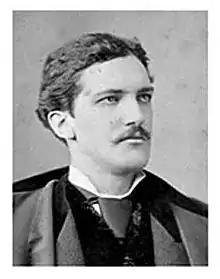Charles B. Atwood
Charles Bowler Atwood (1849–1895) was an architect who designed several buildings and a large number of secondary structures for the 1893 World's Columbian Exposition in Chicago. He also designed a number of notable buildings in the city of Chicago.
Charles Bowler Atwood | |
|---|---|
 | |
| Born | 1849 |
| Died | 1895 |
| Alma mater | Lawrence Scientific School at Harvard University |
| Occupation | Architect |
| Employer | Ware & Van Brunt |
.jpg.webp)

Early life
Atwood was born in Charlestown, Massachusetts in 1849. He attended the Lawrence Scientific School at Harvard University.
Professional training
Atwood trained in the office of Ware & Van Brunt in Boston, where he quickly made a name for himself as a skilled draftsman and designer.[1]
Designs
.jpg.webp)
The buildings Atwood designed for the Columbian Exposition included the Terminal Station and the Fine Arts Building.[1][2] The latter building is the only structure built on the grounds of the Columbian Exposition which still stands in its original location. It houses Chicago's Museum of Science and Industry.
Atwood also designed several other buildings in Chicago, as a member of Daniel Burnham's staff. These include the Reliance Building, and the Marshall Field and Company Building.
Selected works
- Holyoke City Hall, Holyoke, Massachusetts, 1871; partial, H. F. Kilburn completed design in 1874
- Marshall Field and Company Building, Chicago, 1891; partially designed
- Palace of Fine Arts, Chicago, 1893; for World's Columbian Exposition
- Reliance Building, Chicago, 1895; finished work of John Root
- Fisher Building, Chicago, 1895
- Ellicott Square Building, Buffalo, New York, 1895
References
- New York Times (1896-01-01). "The Fine Arts Department" (PDF). The New York Times. Retrieved 2008-02-14.
- New York Times (1893-04-30). "Work of the Late Charles B. Atwood" (PDF). The New York Times. Retrieved 2008-02-14.
External links
![]() Media related to Charles B. Atwood at Wikimedia Commons
Media related to Charles B. Atwood at Wikimedia Commons